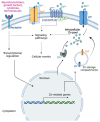Zinc: From Biological Functions to Therapeutic Potential
- PMID: 36902254
- PMCID: PMC10003636
- DOI: 10.3390/ijms24054822
Zinc: From Biological Functions to Therapeutic Potential
Abstract
The trace element zinc (Zn) displays a wide range of biological functions. Zn ions control intercellular communication and intracellular events that maintain normal physiological processes. These effects are achieved through the modulation of several Zn-dependent proteins, including transcription factors and enzymes of key cell signaling pathways, namely those involved in proliferation, apoptosis, and antioxidant defenses. Efficient homeostatic systems carefully regulate intracellular Zn concentrations. However, perturbed Zn homeostasis has been implicated in the pathogenesis of several chronic human diseases, such as cancer, diabetes, depression, Wilson's disease, Alzheimer's disease, and other age-related diseases. This review focuses on Zn's roles in cell proliferation, survival/death, and DNA repair mechanisms, outlines some biological Zn targets, and addresses the therapeutic potential of Zn supplementation in some human diseases.
Keywords: DNA repair; cell death; cell proliferation; therapeutic target; zinc signaling; zinc signals; zinc transporters.
Conflict of interest statement
The authors declare no conflict of interest.
Figures





References
Publication types
MeSH terms
Substances
Grants and funding
LinkOut - more resources
Full Text Sources

